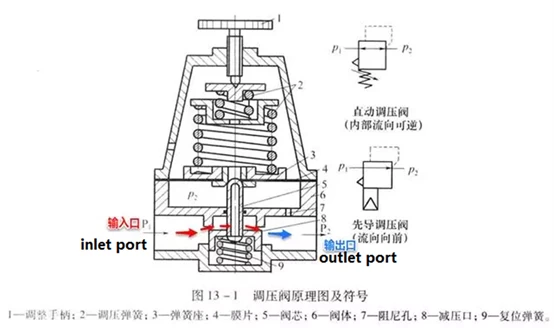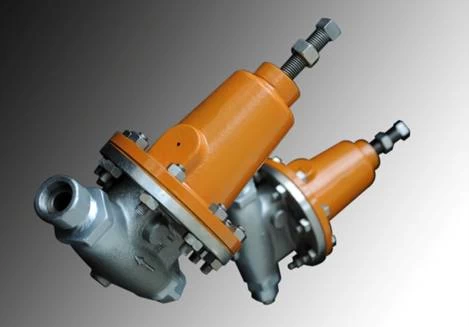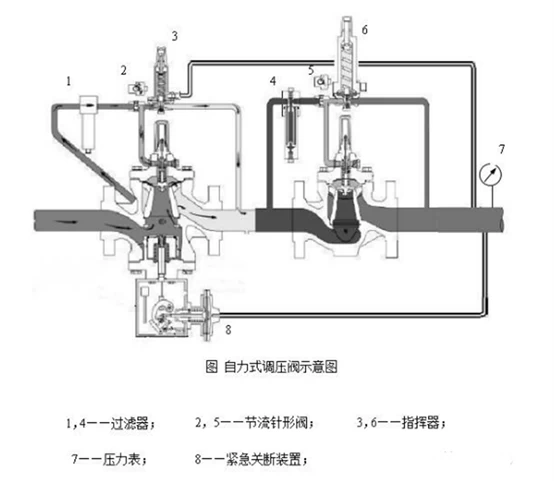Introduction of pressure regulator
Introduction of pressure regulator

As
shown in the figure, the pressure reducing valve port 8 is
in the normally open position, and the size of the valve port opening depends
on the tightness of the handle 1. The tighter the handle is
screwed down, the greater the valve port opening. The high-pressure gas
entering
from the input
port P1 , after passing through the pressure reducing valve port 8 ,
the flow rate increases, but the pressure drops to P2 , and enters the actuator from the output port.
As shown in the figure, most of the decompressed gas enters the actuator, and a small part of the gas with a pressure of P2 enters the diaphragm chamber from the orifice 7 in the figure, creating an upward direction below the diaphragm 4 . When the upward thrust is balanced with the downward spring force of the pressure regulating spring 2 (the balance at this time is a process of dynamic balance), the pressure regulating valve will have a stable pressure output.
If the input pressure P1 suddenly rises, the output pressure will obviously increase accordingly, and the pressure under the corresponding diaphragm 4 will also increase, and the diaphragm will move upward; and the valve core 5 will also move upward under the action of the return spring 9 Push the diaphragm, so that the pressure reducing valve port 8 tends to the position where the opening of the valve port is reduced, the throttling effect of the valve port is enhanced, until the output pressure P2 is reduced, so that the pressure at the upper and lower ends of the diaphragm is balanced again, reducing The output pressure of the pressure valve port stabilizes again.
On
the contrary, as shown in the figure, if the input pressure P1 drops suddenly, the output pressure will obviously drop
accordingly, and the pressure under the corresponding diaphragm 4 will
also decrease, and the diaphragm moves downwards, thus making the pressure
reducing valve port 8. Tend to the position where the
opening of the valve port increases, the throttling effect of the valve port
decreases until the output pressure P2 rises, so that the pressure at
the upper and lower ends of the diaphragm is balanced again, and the output
pressure of the pressure reducing valve port again tends to Yu stable.
There are three
main types of pressure regulators, namely, direct acting, pneumatic diaphragm
and self-operating.
The self-operated
pressure regulator has the advantages of simple structure, convenient
adjustment, operation, and maintenance. It does not need external energy to
drive, but uses the energy of natural gas in the gas pipeline to drive the
adjustment.
 |
working principle
Adjust
the lead screw of the pilot to set the pressure p2 after the valve (a certain
value). At this time, the nozzle and baffle position are in equilibrium,
the nozzle output pressure is constant, the pressure difference of the
regulating valve membrane head is constant (the pressure difference between the
upper and lower diaphragm), the valve opening remains unchanged, the pressure
behind the valve is p2 , and the pressure before the
valve The pressure is p1:
a. If p2 increases, the pressure in the
air chamber at the bottom of the pilot increases, so that the force of the
diaphragm under the pilot is greater than the spring pressure, and the baffle
moves up closer to the nozzle, and the amount of air discharged from the nozzle
decreases, and the regulating valve The pressure in the upper membrane cavity
rises, the pressure difference between the upper and lower diaphragms in the
membrane head decreases, the regulating valve closes, the gas flowing through
the regulating valve decreases, and the output pressure after the valve
gradually drops to the original set pressure value.b. If p2 drops, the pressure in the air chamber at the bottom of the pilot
drops, so that the force of the diaphragm under the pilot is less than the
spring pressure, and the baffle is moved down and away from the nozzle. The
amount of air ejected from the nozzle increases, and the pressure in the upper
diaphragm cavity of the regulating valve decreases. , The pressure difference
between the upper and lower diaphragms in the membrane head increases, the
regulating valve opens, the gas flowing through the regulating valve increases,
and the output pressure after the valve gradually rises to the original set
pressure value.
The adjustment
accuracy of the self-operated regulator is not high, but it can meet the gas
transmission process requirements. Therefore, a large number of gas
transmission stations use self-operated pressure regulators to adjust gas
transmission pressure. The gas pipeline adopts a self-operated pressure
regulating valve with three functions of emergency shutdown, monitoring
pressure regulation, and main pressure regulation.
Self-operated
pressure regulating valve is mainly composed of pilot valve, pressure
regulating valve(such as high pressure control valve), throttle needle valve,
pressure guiding tube, emergency shut-off, etc.

 +86 512 68781993
+86 512 68781993 


















